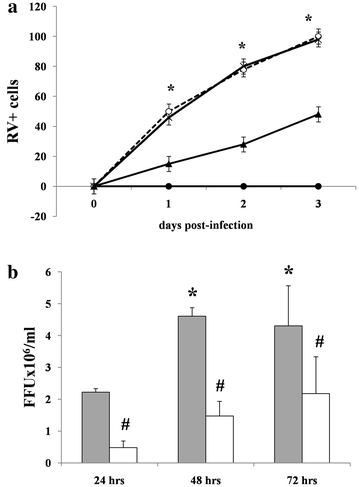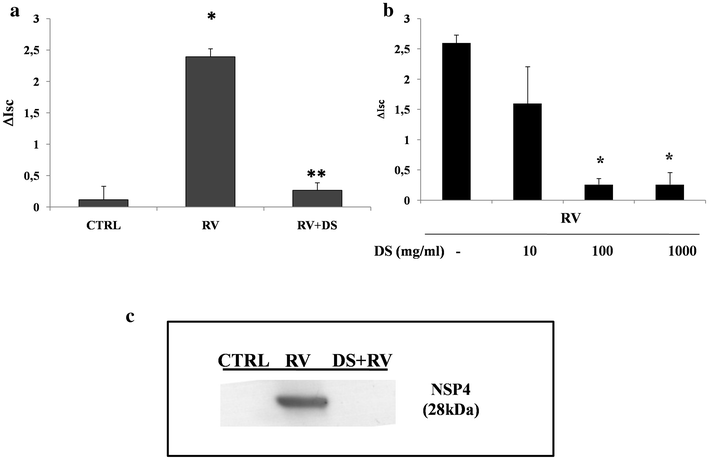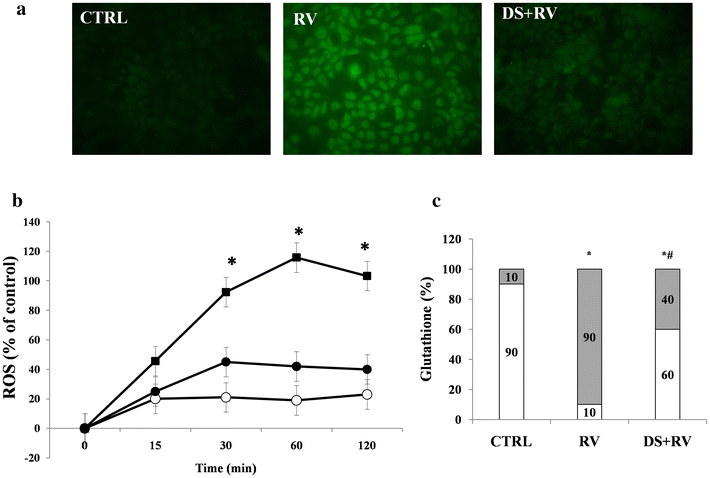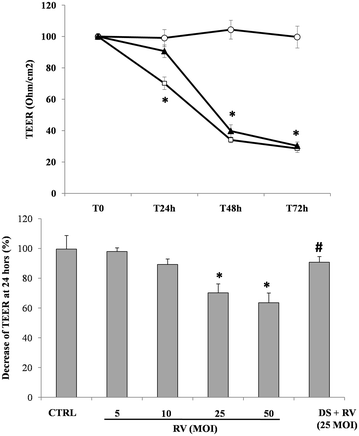Mechanisms of antidiarrhoeal effects by diosmectite in human intestinal cells
- PMID: 28450899
- PMCID: PMC5404323
- DOI: 10.1186/s13099-017-0172-2
Mechanisms of antidiarrhoeal effects by diosmectite in human intestinal cells
Abstract
Background: Rotavirus (RV) induces diarrhoea through a sequence of enterotoxic and cytotoxic effects. The former are NSP4-dependent, induce calcium-dependent chloride secretion and involve oxidative stress. Diosmectite (DS) is a natural clay that has been recommended as an active therapy for diarrhoea, but the mechanism of its effect is not clear. Electrical parameters may be used to measure the direct enterotoxic and cytotoxic effects in polar epithelial intestinal cells. To investigate the effects of DS on RV-induced enterotoxic and cytotoxic damage. Caco-2 cells were used as a model of RV infection to evaluate chloride secretion, epithelial integrity, oxidative stress and viral infectivity in Ussing chambers.
Results: Diosmectite reduced the expression of NSP4 and oxidative stress, resulting in a strong inhibition of chloride secretion. Preincubating RV with DS reduced the cytotoxic effect. Finally, the viral load was reduced by DS but not by control clay. This result suggests that DS specifically affects the early events of RV infection protecting the enterocyte, whereas it does not restore already-established cell damage.
Conclusion: These findings indicate that DS exerts an anti-diarrhoeal effect by inhibiting viral replication and the expression of NSP4. Both ion secretion and cell damage induced by RV are strongly inhibited consequent to the antiviral effect, which explains its clinical efficacy.
Keywords: Chloride secretion; Diosmectite; Oxidative stress; Rotavirus infection.
Figures






Similar articles
-
SARS-CoV-2 causes secretory diarrhea with an enterotoxin-like mechanism, which is reduced by diosmectite.Heliyon. 2022 Aug;8(8):e10246. doi: 10.1016/j.heliyon.2022.e10246. Epub 2022 Aug 18. Heliyon. 2022. PMID: 35996551 Free PMC article.
-
Lacticaseibacillus rhamnosus GG Counteracts Rotavirus-Induced Ion Secretion and Enterocyte Damage by Inhibiting Oxidative Stress and Apoptosis Through Specific Effects of Living and Postbiotic Preparations.Front Cell Infect Microbiol. 2022 Mar 29;12:854989. doi: 10.3389/fcimb.2022.854989. eCollection 2022. Front Cell Infect Microbiol. 2022. PMID: 35425719 Free PMC article.
-
Chloride secretion induced by rotavirus is oxidative stress-dependent and inhibited by Saccharomyces boulardii in human enterocytes.PLoS One. 2014 Jun 11;9(6):e99830. doi: 10.1371/journal.pone.0099830. eCollection 2014. PLoS One. 2014. PMID: 24918938 Free PMC article.
-
Rotavirus induces a biphasic enterotoxic and cytotoxic response in human-derived intestinal enterocytes, which is inhibited by human immunoglobulins.J Infect Dis. 2009 Sep 1;200(5):813-9. doi: 10.1086/605125. J Infect Dis. 2009. PMID: 19604044
-
Clinical role of diosmectite in the management of diarrhea.Expert Opin Drug Metab Toxicol. 2009 Apr;5(4):433-40. doi: 10.1517/17425250902865594. Expert Opin Drug Metab Toxicol. 2009. PMID: 19379128 Review.
Cited by
-
The Role of Purported Mucoprotectants in Dealing with Irritable Bowel Syndrome, Functional Diarrhea, and Other Chronic Diarrheal Disorders in Adults.Adv Ther. 2021 May;38(5):2054-2076. doi: 10.1007/s12325-021-01676-z. Epub 2021 Mar 18. Adv Ther. 2021. PMID: 33738725 Free PMC article. Review.
-
SARS-CoV-2 causes secretory diarrhea with an enterotoxin-like mechanism, which is reduced by diosmectite.Heliyon. 2022 Aug;8(8):e10246. doi: 10.1016/j.heliyon.2022.e10246. Epub 2022 Aug 18. Heliyon. 2022. PMID: 35996551 Free PMC article.
-
Diosmectite inhibits the interaction between SARS-CoV-2 and human enterocytes by trapping viral particles, thereby preventing NF-kappaB activation and CXCL10 secretion.Sci Rep. 2021 Nov 5;11(1):21725. doi: 10.1038/s41598-021-01217-2. Sci Rep. 2021. PMID: 34741071 Free PMC article.
-
Effect of Montmorillonite powder on intestinal mucosal barrier in children with abdominal Henoch-Schonlein purpura: A randomized controlled study.Medicine (Baltimore). 2018 Sep;97(39):e12577. doi: 10.1097/MD.0000000000012577. Medicine (Baltimore). 2018. PMID: 30278566 Free PMC article. Clinical Trial.
-
Investigation of the adsorption capacity of the enterosorbent Enterosgel for a range of bacterial toxins, bile acids and pharmaceutical drugs.Sci Rep. 2019 Apr 4;9(1):5629. doi: 10.1038/s41598-019-42176-z. Sci Rep. 2019. PMID: 30948767 Free PMC article.
References
LinkOut - more resources
Full Text Sources
Other Literature Sources

